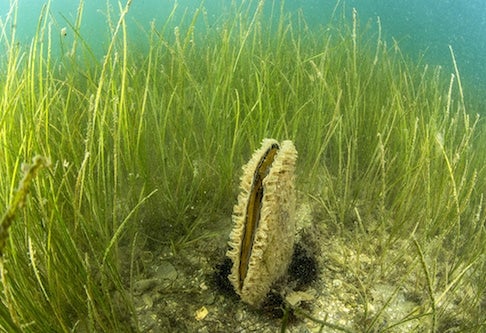
As we have been doing regularly since the beginning of the epizootic that has affected Pinna nobilis, Professor Nardo Vicente has provided an update on the future perspectives for the species, from pockets of resistance to hopes for larval development.
The news is bleak: at present, the only healthy populations in France are to be found in the lagoons, for instance the Etang de Thau, where recent studies* show that the fan mussels are in good health, or the Diana and Urbino lagoons in Corsica, and in certain coastal zones under the influence of the Rhone river waters. “In the open sea“, confirms Nardo Vicente, “only a few isolated individuals have been reported, mainly at Port-Cros where three fan mussels aged between 2 and 3 years were observed and tagged in September. This is also the case at Les Embiez, and at other sites where one or two are still found alive, in places where previously they were very abundant“. During a dive on Friday 13th November at Port-Cros, the news was more positive: a scientist from the MIO sighted eight living fan mussels. But there is no guarantee that these isolated fan mussels will in the medium term survive the parasite.
Collecting samples to save the species
In France, and also in Spain, samples have been collected to try to isolate healthy individuals. Some 200 fan mussels, collected in the Etang de Thau by the team from the CRIOBE (Centre de Recherches Insulaires et Observatoire de l’Environnement) at Perpignan, have recently been put out of harm’s way in the aquarium. José Rafael Garcia March, Director of the IMEDMAR institute at Calpe in Spain, a former student of Nardo Vicente, has also collected a certain number of individuals since the onset of the parasitosis. The primary aim is to conserve fan mussels in good health until the end of the parasitosis crisis, but more needs to be done. Firstly by achieving the reproduction of these individuals, a technique that has today been mastered (PhD thesis by Béatrice de Gauléjac under the supervision of Prof. Vicente in 1993), “but also“, explains Nardo Vicente, “by achieving the development of larvae; we succeeded in doing this in 2014, to the fixed larvae stage” (PhD thesis by Sergio Trigos carried out at the IOPR under the supervision of Prof. Vicente, presented in 2017 at the Universidad Catolica de Valencia). The researchers at the CRIOBE are currently carrying out similar experiments.
The prospect of reimplantations
“If we can manage to obtain young individuals”, explains Nardo Vicente, “we then have to let them grow in controlled environment for at least a year before reintroducing them into the sea, as we have already been doing in the Institute’s laboratories since the end of the 1990s. But the mortality rate among juveniles is very high“. The reimplantation of these juveniles, once the zootic is over, might be a solution to reconstitute the populations. That at least is one of the tracks evoked in particular by the IUCN, which has included the species on the red list of endangered species and has classified it as ‘in critical danger of extinction’.
Limited larval renewal
“For the time being“, Nardo Vicente reminds us, “the renewal of the larvae can only occur in the coastal lagoons and the Corsican lagoons (Diana, Urbino) where the populations have escaped the zootic and are stable. We are incidentally developing a programme for these lagoons with the support of the OEC (Office de l’Environnement de la Corse – Corsica Environmental Agency)”. And when the epizootic is over, it will no doubt be from these populations that we can envisage a dispersal into the open sea. We might also hope that residual populations may manage to develop a kind of resistance to the virus. But for the moment there is no basis for trying to guess at a time frame.
Nardo VICENTE- La Grande nacre de Méditerranée Pinna nobilis. Un coquillage bivalve plein de noblesse. Sciences Technologies Santé. Ed.Presses Universitaires de Provence (2020).
*Inventaire et état de santé des populations de Pinna nobilis (L.1758) dans l’étang de Thau (Hérault, France), 2020. Mathieu Foulquié, Renaud Dupuy de la Grandrive, Nicolas Dalias and Nardo Vicente.
Read the full article (in French) on the site Marine Life website.






















